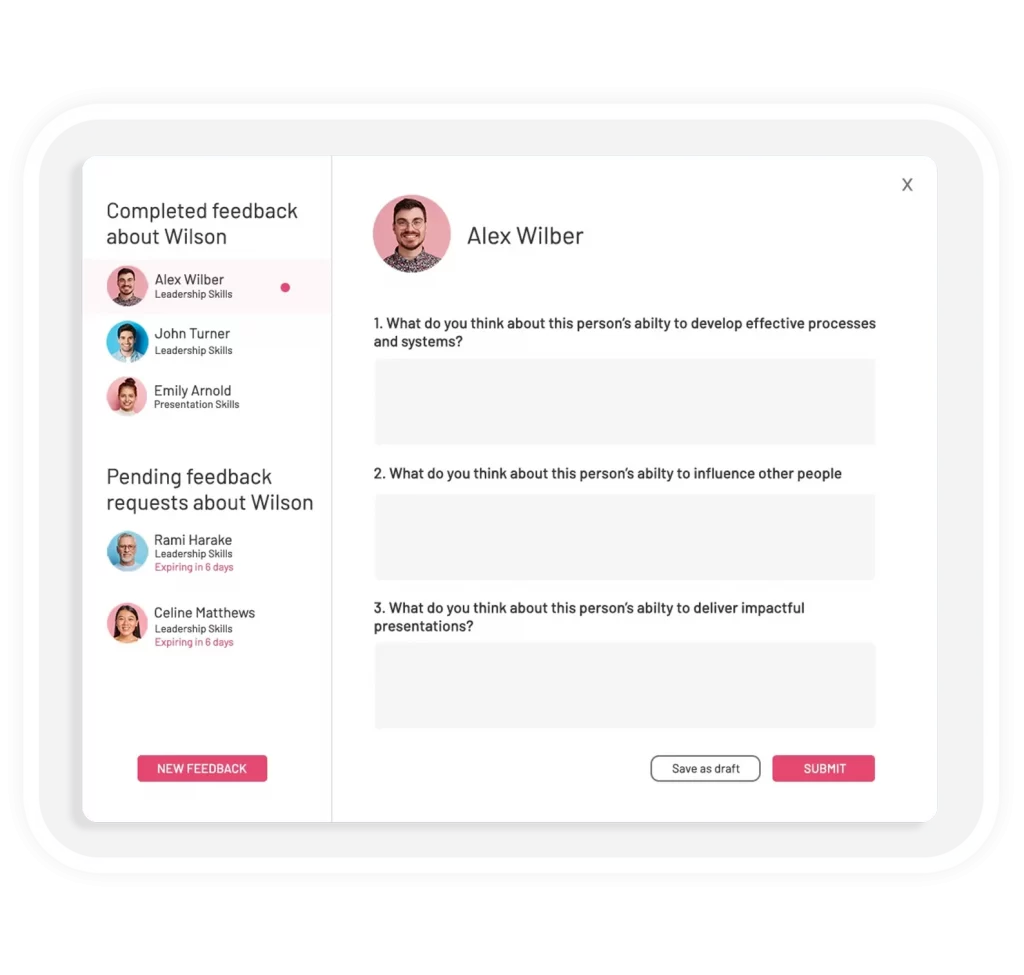We’ve all heard the “Oh my god, feedback is so important!” take at least once during our career, haven’t we? Don’t get us wrong –of course we think that feedback is essential in the workplace. We think feedback is so important that we’re constantly trying to be the best feedback software out there, but we’re not here to advocate giving monotonous feedback and calling it a day.
That’s why today we want to talk about the importance of feedback in the workplace, and how you can give the perfect feedback to your employees or peers!
Remember: feedback is a two-way street, and it’s crucial for employee development, increased productivity, and creating a healthy work environment. Giving and receiving feedback allows employees to improve their skills and performance, encourages a growth mindset and a culture of continuous learning, and helps them identify their strengths and weaknesses.
In order to understand the importance of feedback, we believe that one should understand the subtleties of giving effective feedback. Feedback can only be truly useful if it’s given in the right context, time, and tone. With the right mindset by using feedback, you can increase productivity and create a healthy work environment.
Table of Contents
Importance of Feedback in the Workplace for Employee Development
Helps improve skills and performance
One of the most significant benefits of feedback is that it helps employees improve their skills and performance. When you receive feedback on your work, you gain valuable insights into your strengths and weaknesses, which leads to discovering areas where you excel and others where you struggle. You’ll be able to continuously develop your skills and increase your overall performance, leading to greater success and satisfaction in your job with regular feedback.
It’s important to note that feedback doesn’t always have to be negative. Positive feedback is just as valuable and can help reinforce good habits and behaviors. It’s essential to acknowledge when employees are doing well, as this can boost morale and motivation, leading to even better performance.
Helps identify strengths and weaknesses
Let’s talk about one of the main reasons we give feedback at work: to point out strengths and weaknesses! When you receive feedback on your work, you’ll have a better understanding of where you excel and where you may need to improve, and this awareness is crucial for personal and professional development. It allows you to focus on your strengths and build upon them, while also identifying areas where you may need more support or training.
Regular feedback works as a way to track your progress and growth over time. Seeing where you’ve made improvements and set goals for where you want to go next can be incredibly motivating and empowering, as it allows you to take control of your own development and see the results of your hard work.
Determining strengths and weaknesses has one amazing benefit: it allows you to better understand your role within the organization! You can see how your work fits into the bigger picture and how you contribute to the success of the company, which in result helps you feel more engaged and committed to your work, leading to greater job satisfaction and loyalty to the organization.
Of course, it’s important to remember that feedback should always be given constructively and respectfully. Criticism can be difficult to hear, but when given in a helpful and supportive way, it can be incredibly valuable.

Importance of Feedback for Increased Productivity
Helps understand goals and expectations
The best way to professionally grow and increase productivity is to understand your goals and expectations. Receiving clear and specific feedback on their work helps employees to know exactly what is expected of them and can work towards achieving those goals.
Clear and specific feedback also helps employees stay focused on the most important tasks and priorities. Prioritizing your tasks is essential in the workplace to maximize your productivity, and getting feedback ensures that you are using your time and energy in the most effective way. You can also use a performance management software tool to track your organization’s goals and OKRs, but these don’t mean a lot without giving effective feedback!
Promotes a sense of accountability and ownership
Accountability is one of the most critical aspects of business life –you are expected to own your work and take responsibility. The importance of feedback in the workplace shows itself here: when you get regular feedback, you are held more accountable of your work and decisions. You’ll be more aware of your performance and how it impacts the organization and are more likely to take ownership of your work.
Taking ownership is not restricted to company-wide decisions! Feedback gives you accountability on your professional development. When employees receive feedback on their work, they are able to identify areas where they need to improve and can take action to address these areas. This can involve seeking out training or mentorship or simply working harder to improve in specific areas.
Importance of Feedback for a Healthy Work Environment
Fosters open communication and trust
Now, let’s take a look at the importance of feedback in the workplace in the environmental context. We all want a healthy work environment, and regular feedback fosters open communication and trust throughout your organization. Trusting your managers and peers is crucial for both your and your organization’s overall success, and open communication is the best indicator of trust.
When employees receive regular feedback, they are more likely to feel comfortable sharing their thoughts and opinions with their colleagues and managers, which leads to more open and honest communication.
Also, by conducting regular feedback cycles, you can ensure everyone is on the same page and working towards the same goals. Working towards a common goal is only meaningful if everyone is on the same page, resulting in a sense of camaraderie and teamwork.
Reduces conflicts and misunderstandings
Misunderstandings and conflicts can arise in any workplace, but regular feedback can help to prevent these issues from escalating. Being able to address any concerns or issues before they become bigger problems is such a gift in today’s fast-paced and ambitious workplaces.
Moreover, feedback helps employees to better understand each other’s perspectives and work styles. Whether through peer feedback or goal-oriented feedback, employees are able to gain a better understanding of how their colleagues approach their work and what their expectations are.
Builds a culture of respect and appreciation
Making your employees feel valued and appreciated is the best way to retain employees! But giving recognition and rewards is not important when it comes to show appreciation: you should let your employees know that you see and value their hard work.
When received feedback that recognizes their achievements and contributions, employees are more likely to feel motivated and engaged in their work, resulting in increased job satisfaction and a greater sense of loyalty to the organization. You can check out our best recognition software blog post if you’re insisting on the rewards part!
Furthermore, when feedback is delivered in a respectful and constructive manner, it can help to build a culture of respect and appreciation. Treating your employees with respect and acknowledging their hard work creates a positive and supportive work environment.
Tips for Giving and Receiving Feedback
Use feedback software
Using feedback software can also be an effective way to gather and organize feedback in the workplace. Feedback software allows employees to provide feedback anonymously, which can encourage more honest and open feedback, and provides a centralized location for feedback, making it easier for managers and employees to track and address feedback over time.
Some feedback software even includes features such as goal-setting and progress tracking, which can help employees to stay motivated and focused on their development.
Teamflect is like a Swiss army knife for HR: it offers every performance management feature you could possibly want—and then some.
One of Teamflect’s most unique selling points is its integration with Microsoft Teams, which enables it to conduct a wide range of employee-feedback processes—from pulse surveys to 360 evaluations and customized recognitions.

Teamflect offers incredible performance management and feedback capabilities for organizations of all sizes. Teamflect is a feedback tool that thrives on customization. Every module of Teamflect—Recognitions, Tasks, OKRs, Feedback, and Performance Reviews—can be used independently or together with other modules to create an unparalleled experience for your workforce. Because Teamflect is so easy to use, organizations can easily implement a culture of continuous feedback.
- Provides continuous feedback for effective performance management on Microsoft Teams.
- Presents Power BI Reports that offer users valuable organization insights.
- Facilitates one-on-one meetings with task assignments, note-taking, and feedback tools.
- Boasts a user-friendly design for easy navigation.
- Functions as a Microsoft 360-feedback software for comprehensive performance reviews.
- Allows customizable and automated performance review template gallery
- Offers an extremely streamlined performance management experience.



